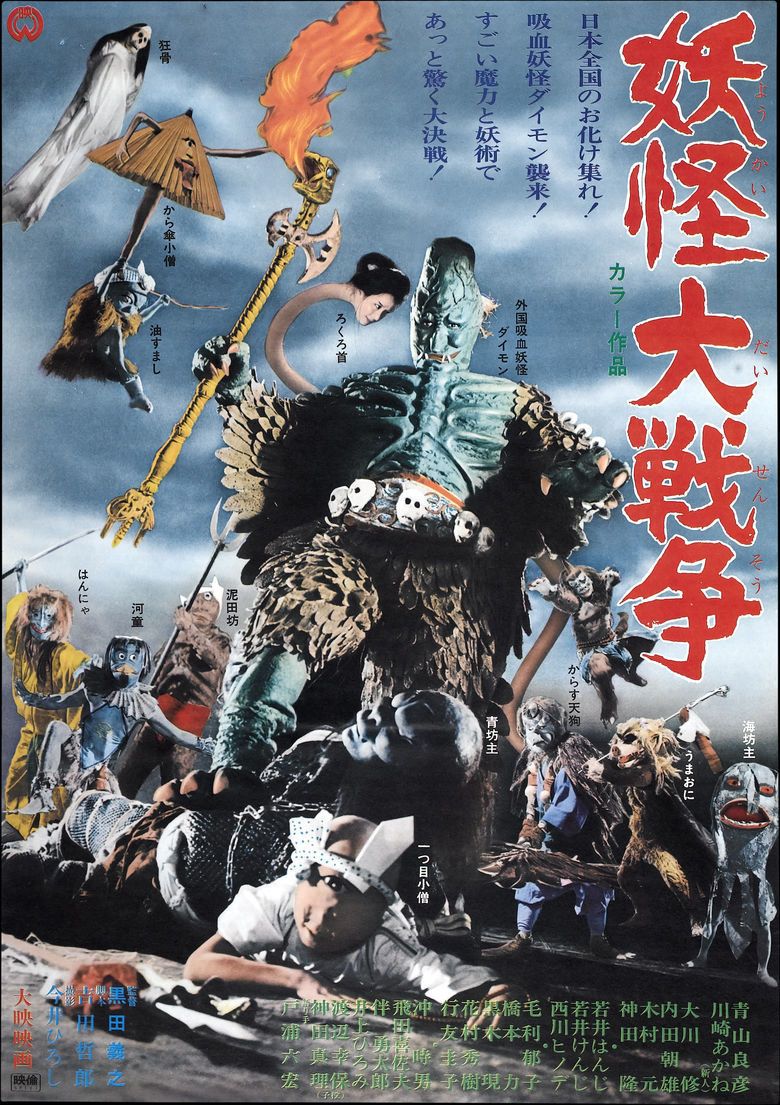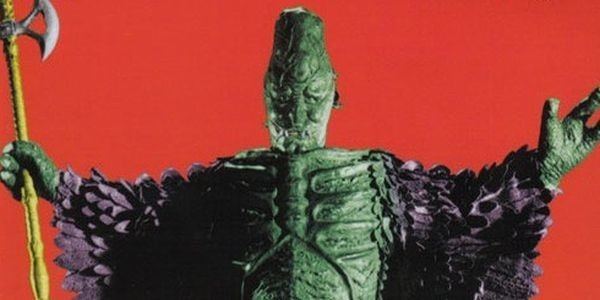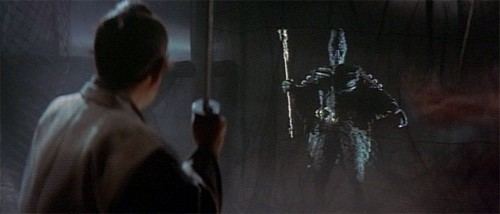Yokai Monsters: Spook Warfare
6.8 /10 1 Votes
| 6.6/10 IMDb | |||||||||||||||||||||||||||||||||
 | ||||||||||||||||||||||||||||||||||
Yokai Monsters: Spook Warfare (Japanese: 妖怪大戦争 Hepburn Yōkai Daisensō, lit. "The Great Yōkai War"), aka Ghosts on Parade, is a 1968 Japanese horror/fantasy film directed by Kuroda Yoshiyuki. It is the second in a trilogy of films produced in the late 1960s, all of which focus around traditional Japanese monsters known as yokai. The film was made in Fujicolor and Daieiscope.
Contents

There were originally three movies made:


The films were produced by Daiei Motion Picture Company, and make extensive use of tokusatsu special effects, with the majority of the creatures being represented by actors in costumes or puppets.

In 2005, director Takashi Miike released The Great Yokai War, a modern retelling of the story which borrows many elements from Spook Warfare.
Plot summary
The film opens in the ruins of the Babylonian city of Ur, with a narration detailing a local legend pertaining to a great monster known as Daimon, who lays dormant in the rubble of the city. Four thousand years later, the ruins are disturbed by treasure hunters, and the monster Daimon (Chikara Hashimoto) is roused and proceeds to kill the intruders by causing a landslide. Following his release, Daimon decides to fly directly to Japan. There, he encounters a Samurai known as Lord Hyogo Isobe (Takashi Kanda), whom he kills and whose blood he consumes. Following this vampiric act, Daimon assumes the form of Isobe and makes his way to the Lord's house. There he is met by Isobe's daughter, Lady Chie (Akane Kawasaki), and fellow Samurai Shinpachiro Mayama (Yoshihiko Aoyama). After killing the family dog for barking at him, Daimon proceeds to tear down all altars in the house and orders his servants to have them burned. In his frenzy, he throws out an ornament which falls into a pond outside, rousing a Kappa (Gen Kuroki). The Kappa decides to investigate the ruckus and happens to see Daimon (as Isobe) drinking the blood of Isobe's steward, Saheiji Kawano (Gen Kimura). When Saheiji also displays Daimon's mannerisms and orders the altars burned, the Kappa becomes suspicious and attacks Daimon fruitlessly. Defeated and hurt, the Kappa goes to the woods to seek out other Yōkai to help him fight back Daimon. The forest is home to the one-legged Kasa-obake, the frightening Futakuchi-onna (Keiko Yukitomo), the long-necked Rokurokubi (Ikuko Mori), the clay monster Nuppeppō, and the wise Abura-sumashi. The Yōkai don't believe the Kappa's story, as they insist such a monster has never been found in Japan. Meanwhile, Lady Chie and Shinpachiro find the maid Shinobu (Hiromi Inoue), who has fallen victim to Daimon's vampirism. Shinpachiro decides to consult his uncle, a priest, who informs him that Lord Isobe is in fact dead and that some demon is masquerading as him. The priest gives Shinpachiro three candles to be placed around the room in which the demon is sitting while the priest chants destruction prayers in order to destroy the demon. While Shinpachiro sets up the candles correctly, Daimon manages to kill the priest by reversing his destructive magic. Daimon announces to Saheiji that he thirsts for younger blood than is afforded him at the house and so goes out looking for children with his retainers. The entourage attack a local family but not before the parents manage to slip their children out the back door. The parents are killed and the retainers ordered to sweep the area to find the children. While the Samurai search, the children bump into Kappa and the other Yōkai, who have set up camp in a local "monster's shrine". Upon hearing of the attack, the Yōkai realise their error and agree to help the Kappa drive Daimon away.
After scaring off the retainers in the forest, the Yōkai set their sights on attacking Daimon. Rokurokubi is the first to attack, winding her neck around Daimon like a hangman's noose. However, Daimon proves to be too strong for her and simply ties her neck into a knot. The other Yōkai try to attack him to much the same effect. Meanwhile, Shinpachiro attempts to ward off the demon using a warded jar. This, however, backfires when it instead entraps the Yōkai. When Shinpachiro manages to shoot Daimon in the eye, Daimon is forced to abandon Lord Isobe's body and flee. Saheiji continues to resist, and Daimon intercepts the new Magistrate, Lord Iori Ohdate (Osamu Ohkawa) who was to be Lord Isobe's replacement. After drinking Ohdate's blood, Daimon assumes control of his body and returns to the house.
During this time, the Yōkai remain trapped in the warded jar. In a fortunate turn, two of the Yōkai not trapped in the jar - Futakuchi-onna and Kasa-obake - encounter the jar. While they are not able to free the monsters trapped inside by themselves, they are able to warn Shinpachiro about Saheiji. They make their way back to the house just in time to see Daimon (as Ohdate) give the order for Shinpachiro to be executed. Futakuchi-onna and Kasa-obake manage to convince Lady Chie to remove the ward keeping the Yōkai trapped inside the jar so that they may be free to fight. Seeing that the Yōkai have got free, Daimon creates half a dozen clones of himself in order to match their number. Just as the Yōkai are on the verge of defeat, Kasa-obake returns with a large army of Yōkai from all over Japan. Daimon continues to clone himself in order to match their numbers, and the Yōkai quickly realise that their only hope of victory is to remove the original Daimon's remaining eye. Daimon transforms himself into a giant, so Nuppeppō takes hold of Kasa-obake's leg as the float up to Daimon's face: stabbing him in the eye and defeating him once and for all. Following the Yōkai's victory, Shinpachiro is released from captivity. The Yōkai all return to their natural habitat having defended their home from the invading Daimon.
Cast
Chikara Hashimoto as Daimon
Akane Kawasaki as Chie
Yoshihiko Aoyama as Shinhachiro
Takashi Kanda as Hyogo
Osamu Okawa as Iori
Keiko Yukitomo as the two-headed woman
Ikuko Mori as the long-necked monster
Gen Kuroki as the river monster
Tomoo Uchida
Gen Kimura
Hanji Wakai
Hideki Hanamura
Tokio Oki
Hiromi Inoue
Mari Kanda
Featured Yōkai
Spook Warfare contains a significant roster of Yōkai from many different sources. Some of the more notable ones are as follows:
Critical reception
The film has received mixed reviews from critics and audiences alike, holding a 6.5/10 score on the Internet Movie Database. Critics praised the film's special effects, but noted with some concern that the violence and frightful nature of the film directly clashed with its supposedly child-friendly tone. Andrew Pragasam noted that while "[there] is plenty of humour and monster fun, [the] horrific elements are remarkably potent for a family film, with gory violence, chills and suspense." Online film critic James Rolfe compared the conflict between the film's light-hearted humour and its violence and use of curses to "watching Beauty and the Beast and one of the tea cups [gouging] out Belle's eye and [telling] her to go to hell." Reviewer Chris Sims downplayed the violent aspects of the film, however, stating that "[as] strange as the movie and its weird monsters might seem, when you get right down to it it’s no more bizarre than the fairy tales we’re all used to on this side of the Pacific, right down to our stories of cursed spinning wheels and hair-accessible towers, and really, the themes are just as universal."
Influence and Legacy
The costumes and puppets (many of which were produced for the first film) are some of the most recognisable realisations of traditional Yōkai illustrations in cinema. The film has been the subject of numerous essays on the subject of Yōkai and their role in modern media, with academics such as Zilia Papp and Michael Dylan Foster making reference to it in numerous publications.
In 2005, Takashi Miike remade the film as The Great Yokai War. The film borrowed numerous elements from the Yokai Monsters series as well as Mizuki Shigeru's Kitarō story of the same name. Mizuki himself even makes a cameo in the film.
References
Yokai Monsters: Spook Warfare WikipediaYokai Monsters: Spook Warfare IMDb Yokai Monsters: Spook Warfare themoviedb.org
